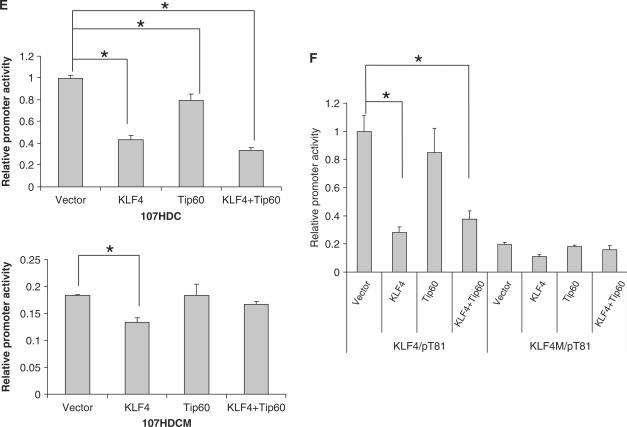Figure 5.
KLF4, Tip60 and HDAC7 formed a complex and cooperatively inhibited HDC promoter activity. (A) HDAC7 was pulled down by KLF4. Coimmunoprecipitation was performed using anti HA-tag antibody after transient transfection of pHA-KLF4 and pFLAG-HDAC7 constructs into AGS cells as described in Methods and Materials section. Anti Flag-tag antibody was used to detect HDAC7 expression in the following western blotting analysis. (B) HDAC7 was pulled down by Tip60. Similar to A, except anti-Tip60 antibody was used for immunoprecipitation. (C) KLF4, Tip60 and HDAC7 cooperatively repressed 1.8 kb HDC promoter activity. KLF4, Tip60, HDAC7 expressing plasmids with their respective vectors were cotransfected into AGS cells in combination of three constructs with the full length 1.8 kb HDC promoter reporter. Forty-eight hours after transfection, cells were lysed, luciferase activities were measured and relative promoter activities were calculated as described in Materials and Methods section. HDAC1 construct was also used as a control for HDAC7. (D) KLF4, Tip60 and HDAC7 cooperatively repressed 107 bp HDC promoter activity. Similar to panel C except the minimal 107 bp human HDC promoter reporter was used instead of the full length 1.8 kb HDC reporter. (E) Tip60 lost its inhibitory effect when a major KLF4 responsive element (Sp1 binding GC box) was mutated in the HDC promoter. Cotransfection experiments were formed similarly as described above with wild-type 107 bp human HDC promoter reporter (top) and mutant reporter (bottom) with mutations in the upstream GC box. (F) Tip60 did not have any effect on a KLF4 responsive artificial promoter. Cotransfection experiments were formed similarly with an artificial reporter KLF4/pT81 with a KLF4 binding site and various combinations of KLF4 and Tip60 overexpression constructs. A mutant reporter (KLF4M/pT81) with mutations in the KLF4 binding site was also used in the experiment. Means ± SD for three independent experiments were shown for reporter assays (panels C–F), and major statistical difference (P < 0.05) of the relative promoter activities of the transfection experiments was indicated by a star (*).


